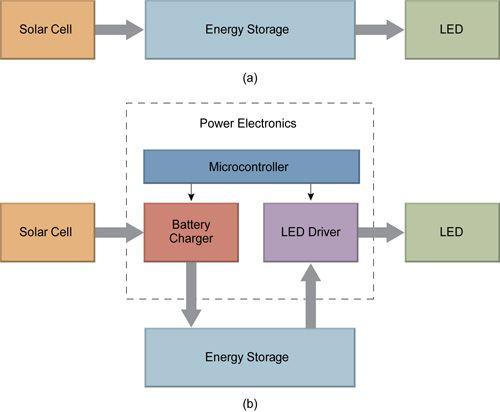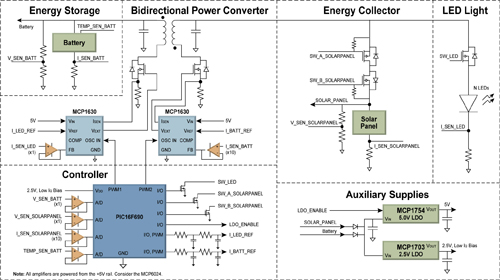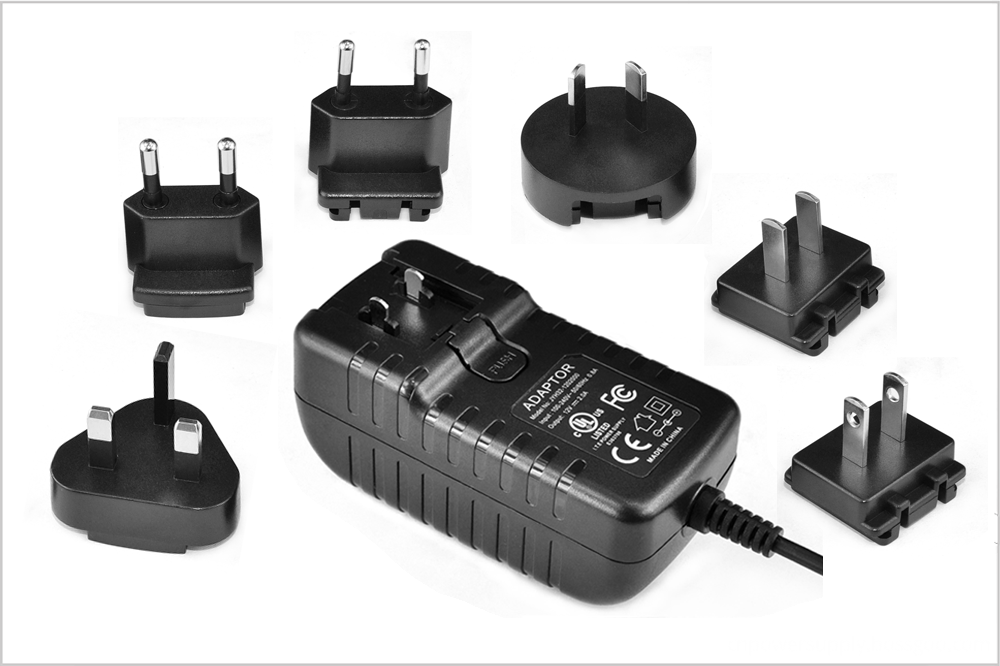With the rapid development of technology, the performance of Light-Emitting Diode (LED) and solar photovoltaic cells has been significantly improved, which in turn helps to improve the performance of the final application. For applications that use both technologies (such as solar lighting applications), advances in these two core technologies will greatly enhance the potential for improved end-application performance. At this time, since the solar cell is more efficient, more solar energy can be converted into electric energy, so that the area of ​​the required solar cell can be reduced, and the high-efficiency LED can be illuminated at night for a longer time and the light is brighter. However, the challenge for manufacturers of solar lighting solutions will be how to take advantage of technological advances quickly and cost-effectively. One way to maximize system performance is to use energy conversion strategies. With a solid energy conversion strategy, users can quickly develop and deploy solutions that take advantage of the latest technology. In this article, we will examine components, develop systems, and introduce an advanced approach to analyzing system characteristics. background There are countless examples of solar lighting. Whether it's the use of solar-powered desk lamps as night-reading lights in areas with unstable grids or the full deployment of public street lighting, the demand for solar/LED lighting systems is characterized by diversity, acceptance and globalization. The only difference is the size of the demand for the final application (reading is quite different from the requirements for general lighting). The core components of all such systems include: i) solar cells; ii) batteries; iii) LEDs. If used in a broader sense, these components are: solar collectors (solar cells), energy storage devices (batteries), and Energy consuming device (LED). Although this is not very accurate, it helps to highlight the flexibility of the analysis. Figure 1a shows the most basic system configuration.    Figure 1: Two system configurations However, for this to work, the characteristics of each component must be compatible with each other. For this example, this means that the output voltage/current characteristics of the solar cell must match the charging curve of the battery, and the discharge curve of the battery must meet the driving requirements of the LED. We quickly discovered that the configuration in Figure 1(a) does not meet the above requirements. Component overview Recalling the performance characteristics of each component, as shown in Figure 2 (a to d), we found that although the characteristics of these components can be made close to each other in a limited configuration set, it is almost impossible to achieve reasonable results. Performance level. We quickly discovered that the voltage of a solar cell (single-cell battery) is up to about 1V, while the operating voltage of a NiMH battery is between 0.9V and 1.4V, and although the forward voltage of the LED is usually higher than 3V, it needs constant Stream source. In addition, NiMH batteries have a special charging requirement for extended life. Although it is possible to develop a system to directly connect all components, it should be clear that this configuration has significant limitations and can adversely affect overall system efficiency and stability.    Figure 2: Component volt-ampere characteristics and drive requirements To break these limits, we can look at the alternative system diagram shown in Figure 1(b). This system configuration adds a power electronic interface between the three core components, which greatly increases the flexibility of the system and optimizes the overall performance of the system. In this configuration, the microcontroller is not essential. A separate battery charger integrated circuit (IC) can be used to meet the NiMH charging curve requirements. Similarly, an LED driver IC can be used to convert the battery voltage to a constant current source. However, this configuration has at least the following two disadvantages. First, flexibility is limited. The operating range of selected devices is likely to be narrow, which limits their ability to respond to system changes or customer needs. For example, if the configuration of the solar cell changes, the battery charging IC needs to be replaced. If the energy storage technology or configuration changes, it is likely that the battery charging IC and the LED driver IC need to be replaced at the same time. Finally, if the type or configuration of the LED changes It is necessary to reconfigure the LED driver IC. Given the speed of innovation in these technologies, only the flexibility to meet the standards can respond more quickly to changing needs. The use of a microcontroller will enhance the system and the flexibility of the entire solution. At this point, if the hardware changes greatly, there will be no need to re-do a lot of design and verification work, because most of the changes can be implemented inside the microcontroller. The second drawback is reflected in the system optimization component. While a universal battery charging IC is readily available, it is difficult to find a battery charging IC that includes the Maximum Peak Power Tracking (MPPT) algorithm to maximize the output of the solar cell. Discrete solutions struggle to keep up with the pace of technological innovation. Suggested implementation To break through the limitations of custom solutions, microcontrollers can be introduced into the system so that designers can not only take full advantage of the enhanced performance of each core component, but also reuse the basic architecture. Figure 3 shows the proposed implementation.    Figure 3: Suggested architecture based on MCU The implementation shown in Figure 3 has three major advantages. First, it is easy and quick to optimize all aspects of the system. The solution includes four main systems: LEDs, batteries, solar cells, and power electronics. As described above, the battery charging curve should be controlled to improve the charging efficiency of the battery and extend its service life. The overall charging efficiency is also related to the efficiency of the solar cell. Integrating the MPPT curve into the energy conversion algorithm can improve the overall efficiency of the solar energy conversion, and at the same time achieve the charging target, and ultimately reduce the size of the solar battery. This affects the shape of the product, giving designers the opportunity to enhance the visual impact of the product. Similarly, the target application may determine the quality of the light as a key feature, as is the application for reading. The quality of the light depends on the current waveform, which may be a strict tolerance for the LED drive current, perhaps including dimming. With the proposed implementation, the design engineer can optimize the efficiency of the component to the overall stability and longevity of the system. Second, the architecture is fully scalable and supports a wide power range. The portable compact desk lamp for reading lighting can have a solar cell, an off-the-shelf NiMH rechargeable battery and several LEDs with a drive current of 20-75 mA. This design requires only a few power transfer components (including off-the-shelf power MOSFETs and transformers). , you can quickly adjust the power rating to meet the needs of commercial and public safety lighting. For example, you can increase the number of solar cells, replace the off-the-shelf NiMH battery with a custom battery pack, and use a high-power, high-current LED with a drive current of 350 mA or more. The third major advantage is the flexibility of the platform, which allows designers to quickly adjust to changes in core technology, user needs, or user behavior. For example, upgraded solar cells or new LEDs with special drive requirements can be quickly adopted to speed up the introduction of new products. Taking advantage of feedback from customers in the use of these products may also spawn other non-core features such as communications (such as serial to wireless interfaces) and predictive diagnostics. As a result, the solution not only adjusts and optimizes performance based on changing conditions, but also informs the user about their relative health and predicts when maintenance is needed. in conclusion As with most emerging technologies, we are not always sure about where to go. But the two emerging technologies (such as PV solar cells and LEDs), once combined with the flexibility of a microcontroller-based power converter solution, will quickly improve application and meet customer needs.
Wall plug adapter
with interchangeable plugs, AC Switching Adapter with
detachable AC plug, universal adapter, switching interchangeable power adapter,
interchangeable power supply,16V Detachable Plug Power Adapter with 6 different
plug types (CN, USA, EU, KR,AU and UK).
16V detachable plug
power adapter for tablet, bluetooth speaker, massage chair, humidifier,
juice extractor, coffee machine, small household appliance, fingerprint
scanner, CCTV camera-etc
With these 6 interchangeable
plug -- CN,KR,US,EU,AU,UK plug, you can only take one 16V wall plug in power
adapter with you when you traveling among these 6 countries.
We can also make it
with more plugs if you tell us your specific requirement.
16V Detachable Plug Power Adapter 16V Detachable Plug Power Adapter,Interchangeable Detachable Power Adapter,Detachable Power Adapter Shenzhen Juyuanhai Electronic Co., Ltd. , https://www.powersupplycn.com



0 times
Window._bd_share_config = { "common": { "bdSnsKey": {}, "bdText": "", "bdMini": "2", "bdMiniList": false, "bdPic": "", "bdStyle": " 0", "bdSize": "24" }, "share": {}, "image": { "viewList": ["qzone", "tsina", "tqq", "renren", "weixin"], "viewText": "Share to:", "viewSize": "16" }, "selectShare": { "bdContainerClass": null, "bdSelectMiniList": ["qzone", "tsina", "tqq", "renren" , "weixin"] } }; with (document) 0[(getElementsByTagName('head')[0] || body).appendChild(createElement('script')).src = 'http://bdimg.share. Baidu.com/static/api/js/share.js?v=89860593.js?cdnversion=' + ~(-new Date() / 36e5)];